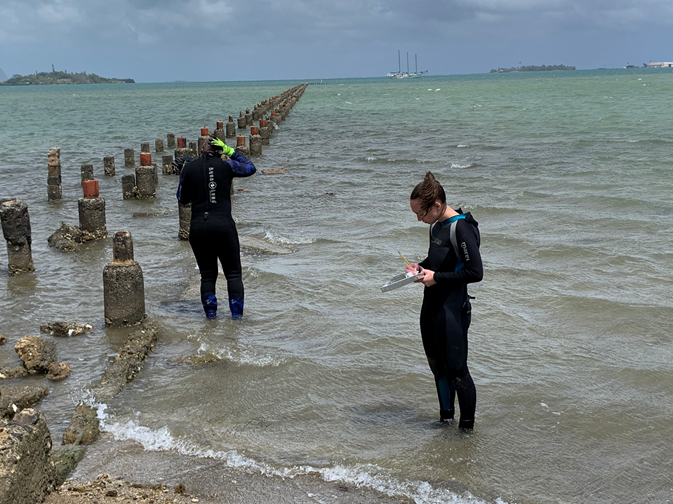
The Mussel Watch Program has monitored the nation’s coastal waters for chemical contaminants since 1986 and in recent decades has expanded its monitoring to include trace metals, legacy contaminants, and contaminants of emerging concern (CECs). In 2024, the program collected mussel (Mytilus sp.) samples from a network of 67 sites along the Pacific West Coast and Alaska and collected oyster (Ostrea sandvicensis) samples from a network of five sites in Hawaii. Results from this study will support a better understanding of the sources, fate, and transport of contaminants in the region and will fill important data gaps for local stakeholders.
Why We Care
In the Pacific Northwest, toxic contaminants originating from human activities, such as fuel combustion and industrialization, continue to be introduced to the environment, raising concerns about the health of marine ecosystems in the region. Contaminant monitoring is critical in this ecosystem to protect fish and shellfish, ensure seafood safety, and promote remediation efforts and the recovery of ecosystems.
Additionally, California’s current ocean economy is dominated by tourism and recreation, marine transportation, and offshore mineral extraction (NOAA Office for Coastal Management, 2015). With nearly two-thirds of the California population residing in coastal counties, the health and water quality of coastal ecosystems is heavily tied to human activities in the region (NOAA Office for Coastal Management, 2015). Alaska and Hawaii have historically represented more pristine coastlines, and, as such, are important to include in the the Mussel Watch dataset as a comparison for other assessed areas of the US coast. Thousands of chemical contaminants from many land-based point and nonpoint sources accumulate in the Pacific West Coast region, Alaska, and Hawaii every day, compromising water quality and, consequently, threatening human and ecosystem health.
Previous studies in the region have investigated legacy contaminants, such as trace elements and persistent organic pollutants (e.g., polychlorinated biphenyls (PCBs), organochlorine pesticides, chlordane, and polycyclic aromatic hydrocarbons (PAHs)). These research and monitoring efforts have helped managers limit the impact that legacy contaminants have on coastal ecosystems, but such efforts are lacking for the increasing number of new and unregulated compounds known as contaminants of emerging concern (CECs), many of which are known to be harmful to people, animals, and the environment. In response to resource managers’ concerns about the extent and impact of these chemical stressors, the Mussel Watch Program conducted a basin-wide survey in 2024 to assess the magnitude and distribution of a suite of CECs, metals, and legacy contaminants in the Pacific West Coast region, Alaska, and Hawaii.
What We Are Doing
The Mussel Watch Program uses an ecosystem-based approach to monitoring, which entails measuring the concentration of chemical contaminants in sediments and the tissues of indigenous bivalves, such as oysters and mussels, as a way to evaluate local environmental quality. Bivalves are used as indicator organisms for chemical pollution because they tend to bioaccumulate contaminants from the large amounts of water they filter, they have limited mobility, and they are found throughout the U.S. coastal zone.
The program currently analyzes sediment and bivalves for both legacy contaminants and CECs. Legacy contaminants, monitored by Mussel Watch since 1986, include compounds such as chlordanes, chlorobenzenes, dichlorodiphenyltrichloroethane (DDT), dieldrins, endosulfans, hexachlorocyclohexanes (HCHs), butyltins, PAHs, and PCBs. The monitoring of CECs began in 2009 and includes contaminants such as alkylphenols, alternative flame retardants, current-use pesticides, (per- and polyfluoroalkyl substances (PFASs), polybrominated diphenyl ether (PBDEs), polybrominated biphenyls (PBBs), and pharmaceuticals and personal care products. In general, CECs are minimally regulated, not commonly monitored, but potentially toxic chemicals that are finding their way into the environment.
In 2024, Mussel Watch analyzed sediment, mussel (Mytilus sp.), and oyster (Ostrea sandvicensis) samples from a network of 72 sites in the Pacific West Coast region, Alaska, and Hawaii for metals, legacy contaminants, and CECs. In this survey, 67 samples of mussels and five samples of oysters were collected across the coastlines of California, Oregon, Washington, Alaska, and Hawaii (Oahu) following standard Mussel Watch Program protocols. Sites were selected based on recent success of historic site locations and the availability of collaborator support in the region.
The national Mussel Watch Program designed the 2024 Pacific West Coast region, Alaska, and Hawaii chemical stressors survey in collaboration with California Department of Fish and Wildlife (CDFW), the Tolowa Dee-ni’ Nation, the Resighini Rancheria, the Channel Islands NMS, the Greater Farallon Islands NMS, the Monterey Bay NMS, the Southern California Coastal Water Research Program (SCCWRP), the Tijuana River NERR, the San Francisco Estuary Institute (SFEI), Washington Department of Fish and Wildlife (WDFW), Oregon Department of Fish and Wildlife (ODFW), the Pacific Islands Fisheries Science Center (PIFSC), Alaska Sea Grant, NOAA Kasitsna Bay laboratory, the National Parks Service (SWAN, SEAN), the Prince William Sound Regional Citizens’ Advisory Council (PWSRCAC), the PWS Science Center, and the PWS Aquaculture Corporation (PWSAC).
Benefits of Our Work
This study supplies much-needed data to the national Mussel Watch Program and local stakeholders and managers in the Pacific West Coast region, Alaska, and Hawaii and informs water quality data used by coastal resource managers to develop effective, long-term policies to protect ecosystem services provided by the Pacific West Coast region, Alaska, and Hawaii.

